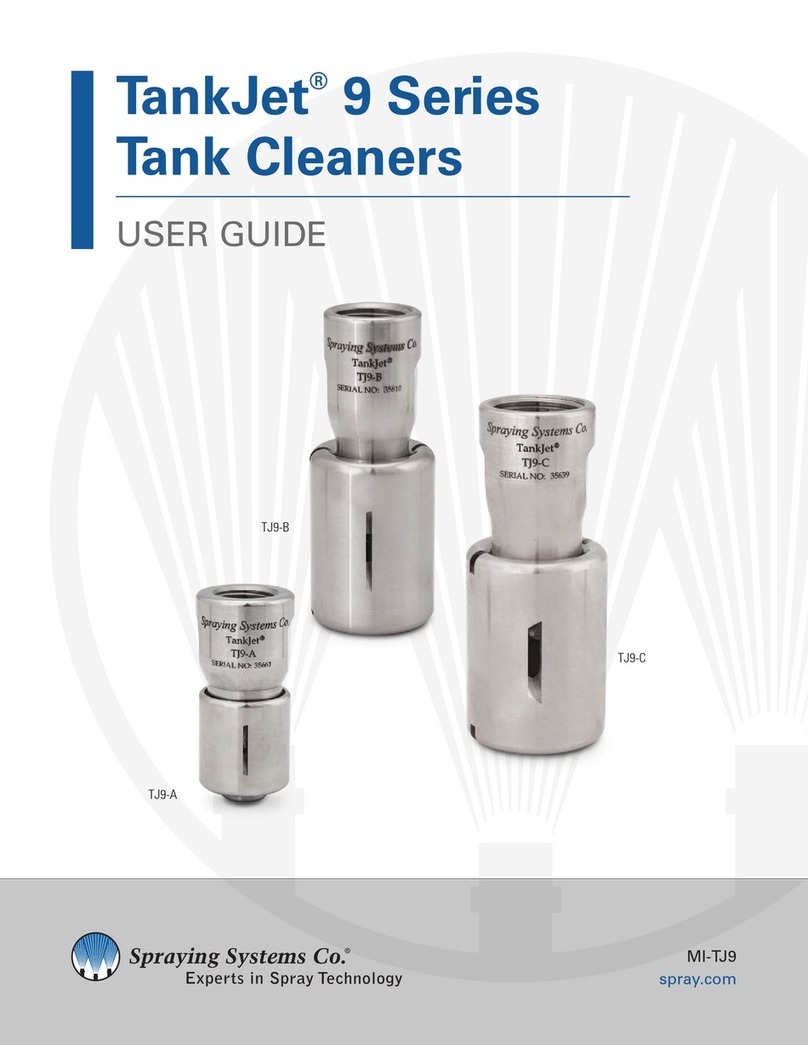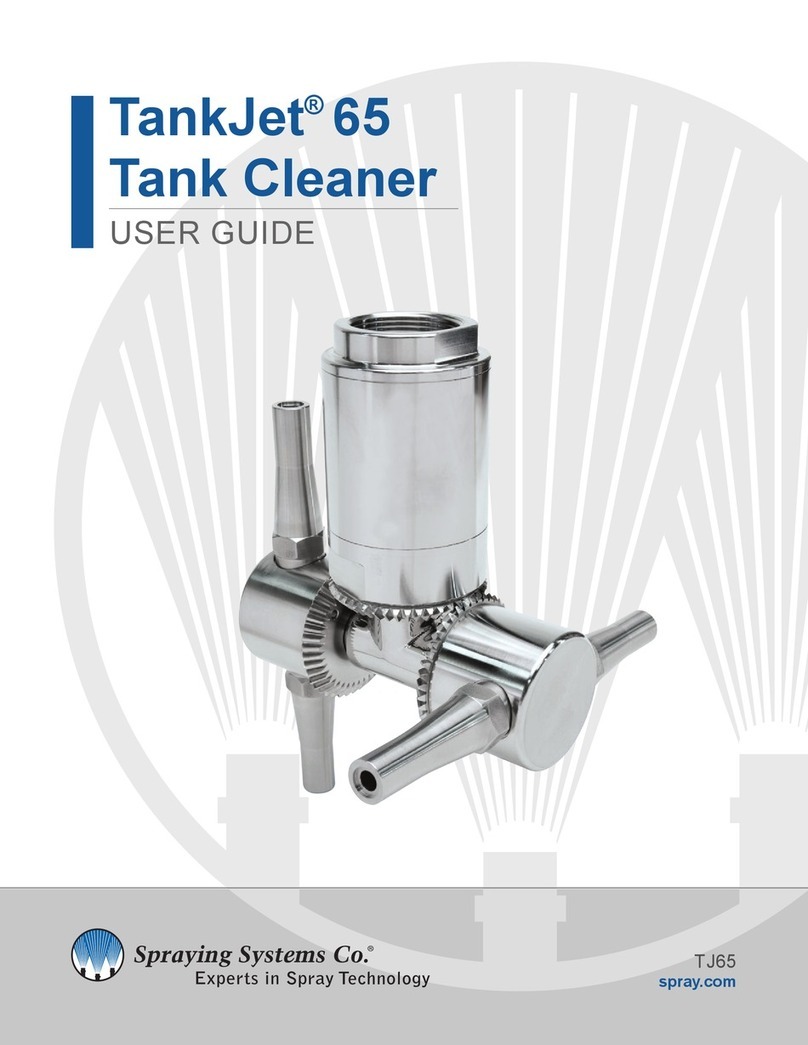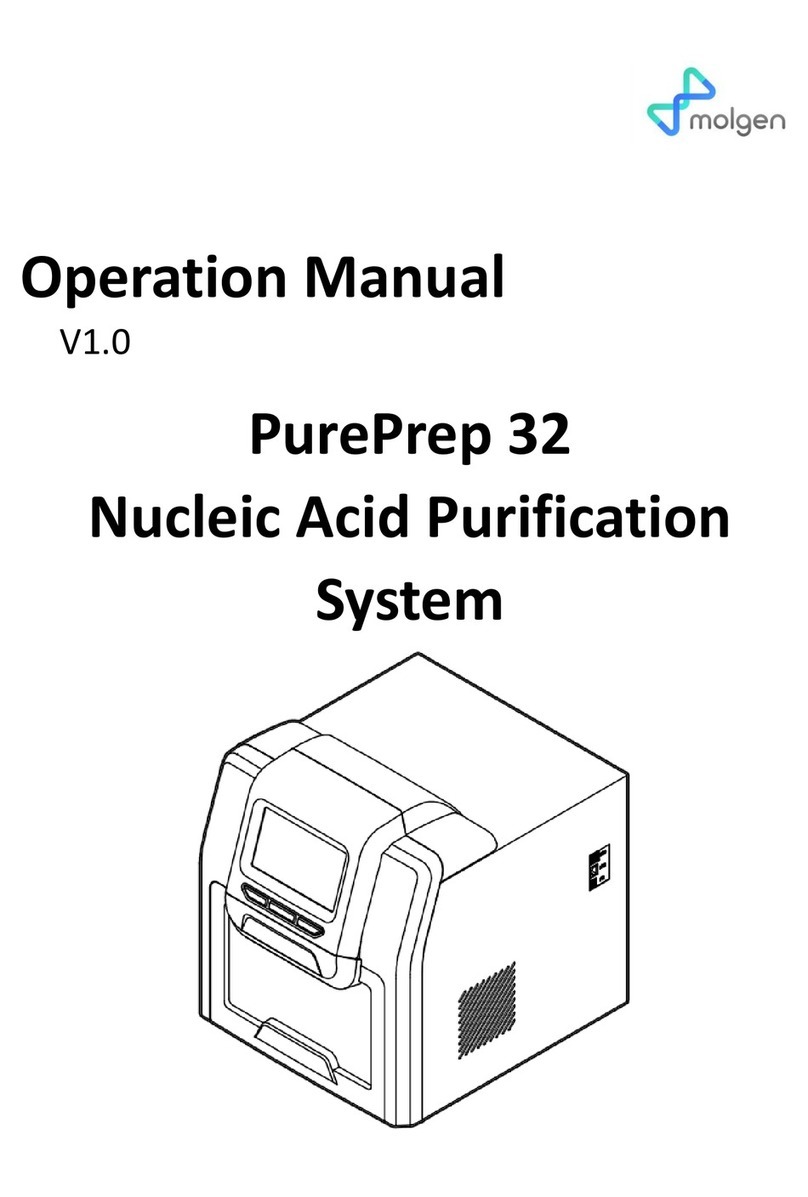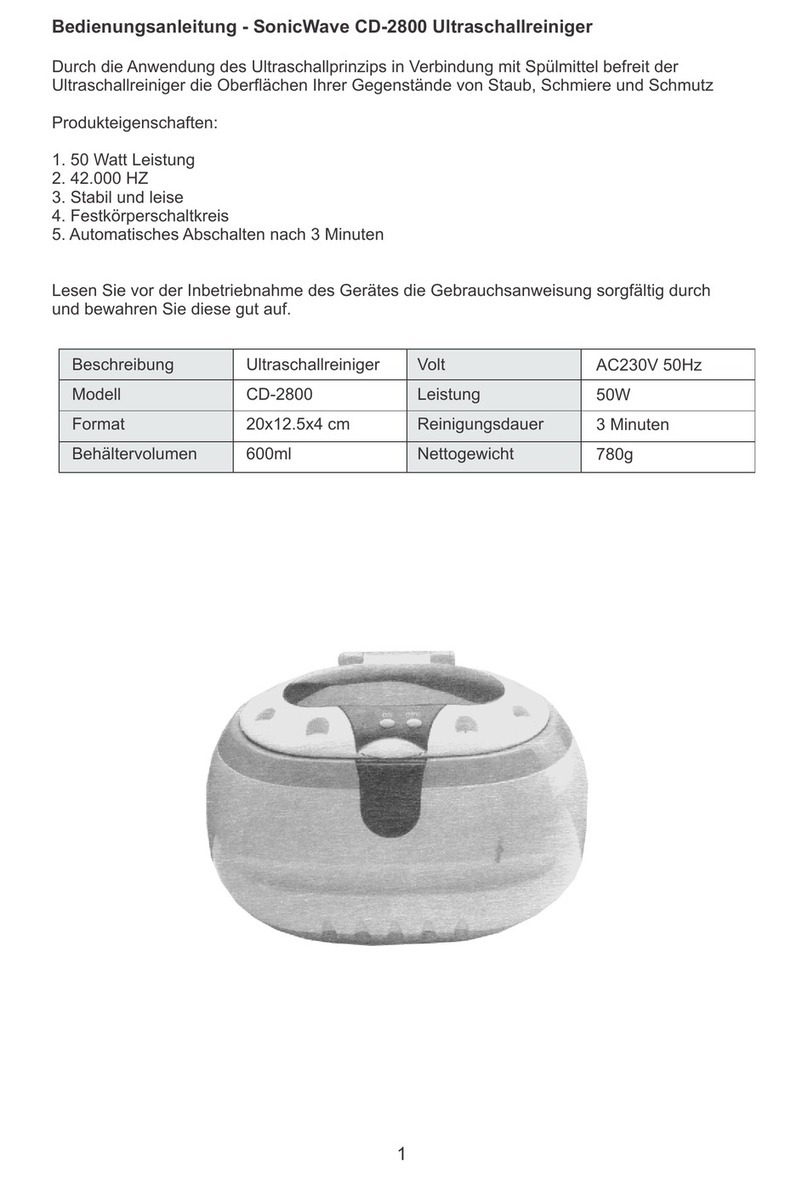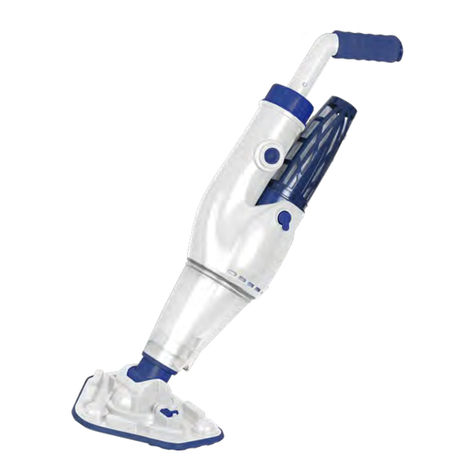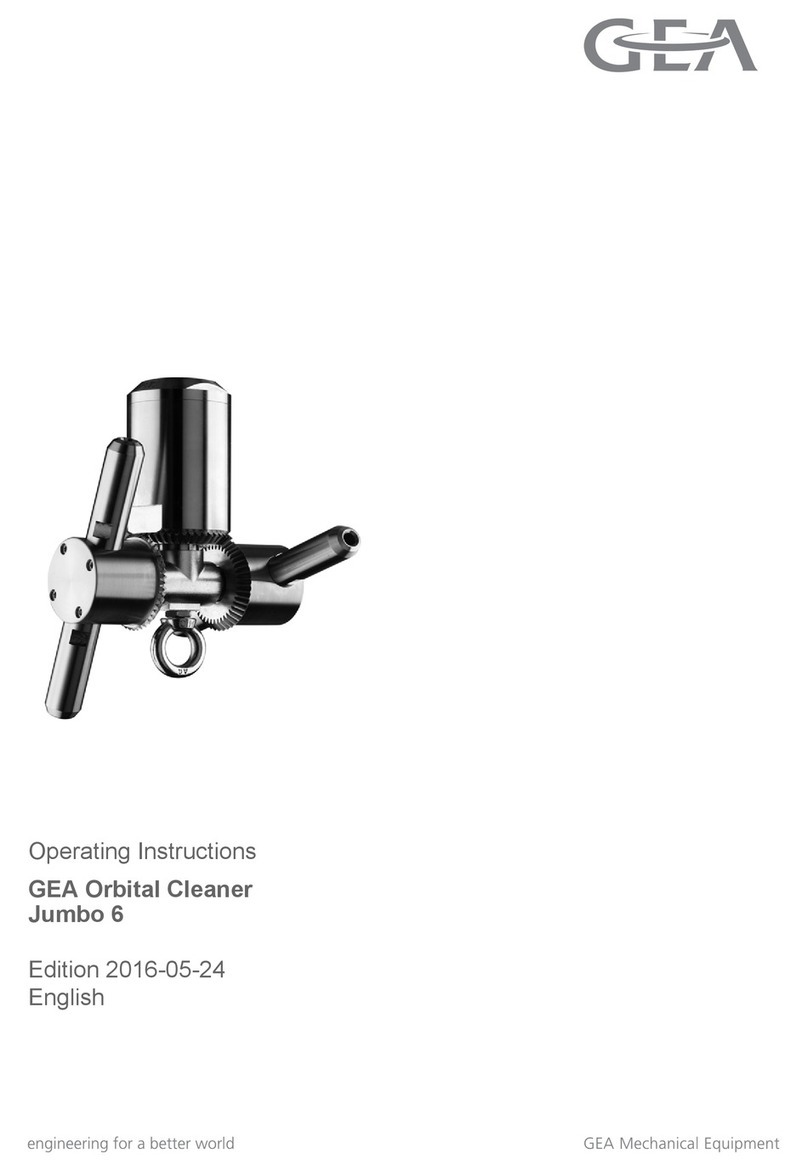Spraying Systems TankJet AA290E-EP Series User manual

10
TankJet®
AA290E-EP Series
Tank Cleaner
USER GUIDE
spray.com
MI-AA290E-EP
TankJet AA290E-EP
Electric Motor-Driven
Tank Cleaner

2
CONTENTS
CONTENTS .....................................................................2
FORWARD .....................................................................2
INTRODUCTION .............................................................2
SPECIFICATIONS.............................................................2
DATA SHEETS.................................................................3
SAFETY PRECAUTIONS ...................................................5
Installation Precautions................................................5
General Safety ..............................................................6
Operation Precautions .................................................6
MAINTENANCE ..............................................................7
WARRANTY ...................................................................8
PARTS LIST.....................................................................9
MAINTENANCE RECORD ..............................................10
DECLARATION OF CONFORMITY..................................11
IMPORTANT: PLEASE READ ALL INSTRUCTIONS BEFORE
INSTALLING OR OPERATING UNIT. SAVE FOR FUTURE
REFERENCE.
PROPRIETARY NOTICE
The information contained in this document is the
exclusive property of SPRAYING SYSTEM CO.
Reproduction in whole or part is prohibited without prior
consent of SPRAYING SYSTEMS CO.
FORWARD
The equipment and/or parts described in this document
were manufactured and assembled with quality and high
reliability, which have become synonymous with the
name Spraying Systems Co. The description and
specifications contained herein were effective on the
revision date of this MI. Spraying Systems Co. reserves
the right to alter or modify any unit specification on
Spraying Systems Co. product without notice or
obligation.
INTRODUCTION
This tank washer meets the requirements set forth in EC
Directive 2006/42/EC. The latest motor manufacturer’s
Operation & Maintenance Manual is included with this
tank washer as a separate manual since important safety
precautions pertaining to the installation and operation
of the motor itself are included.
SPECIFICATIONS
Liquid Pressure: 250 psi (17 bar) max.
Flow Rates: Up to 284 gpm (1075 l/m)
Liquid
Temperature:
200 degrees F (93 degrees C)
max.
Electrical Motor: 120 Volt AC or 240 Volt AC
Tank Diameter: 100 ft. (30.5 m) max.
recommended
Min. Tank
Opening:
Spray Head with two nozzles
fits through a 7.25” (184.1 mm)
dia. opening
Spray Head with four nozzles
fits through a 8.25” (209.5 mm)
dia. opening
Tanks over the specified diameters could possibly be
cleaned adequately depending on the maximum tank
dimension, cleaning solutions being used, temperatures,
spray pressures, flow rates and the material being
cleaned from the tank.
The tank washer may be used with plain water or with a
variety of chemicals (compatible with 316 SS, ethylene
propylene rubber, and carbon graphite filled Teflon®).
However, if chemicals are used, review MSDS sheets and
chemical compatibility with material used to construct
this product. Also, the unit should be flushed with clean
water at the end of the day before the unit is stored. A
liquid line strainer ahead of the unit is recommended to
remove large particles which may damage the unit.

3
DATA SHEETS

4

5
SAFETY PRECAUTIONS
YOUR SAFETY AND THE SAFETY OF OTHERS IS
EXTREMELY IMPORTANT.
We have provided important safety messages in this
manual for your product. Always read and obey all safety
messages.
Safety alert symbols alert you to hazards that can kill or
harm you as well as others. The safety alert symbol and
the words “DANGER” and “WARNING” will precede all
safety messages. Read the following words and what
they signify:
DANGER: You may be killed or seriously
injured if you don’t follow these instructions.
WARNING: You may be seriously injured if you
don’t follow these instructions.
All safety messages will identify the hazard, tell you how
to reduce the chance of injury and tell you what can
happen if the safety instructions are not followed.
NOTE: Certain atmospheres within the tank being
cleaned could become explosive, such as dust particles
in a flour silo, or fumes in paint mixing tanks. For this
reason, the following safety precautions should be
observed.
INSTALLATION PRECAUTIONS
Qualified personnel must perform all work required to
assemble, install, operate, maintain and repair this
equipment. Improper installation and operation can
result in severe personal injury and/or damage to
property. Correct installation is your responsibility.
WARNING: Install proper guards as needed.
Follow basic lifting guides when transporting or
handling this product. Failure to follow this
instruction can result in back injury, burns or other
serious injury.
CONNECTIONS
Please refer to datasheet 290E-EP during installation.
Also reference the instructions for the electric motor
shipped with the 290E-EP tank washer. Connect the
power supply to the conduit connection hole as shown
on datasheet 290E-EP, and verify that the nozzle hub
rotates clockwise when viewed from the nozzle hub end.
Connect the liquid line to the inlet connection of the
liquid inlet body.
WIRING
Route cabling through the most appropriate conduit
entry making sure that cables will not foul on the cover
assembly or internal components after refitting. Refer to
the motor wiring diagram for connection details. Wire
type must meet local and certifying agency (CSA, IEC Ex,
ATEX, etc.) requirements and have a minimum
temperature rating of 88°C.
MOUNTING
Bolt or clamp the unit to the tank to be cleaned as
dictated by the mounting flange provided. Adjustable
flanges allow easy positioning of the tank wash unit
to various spray depths for maximum cleaning
effectiveness.
LIQUID INLET CONNECTION
Proper installation requires liquid supply line (pipe, hose,
etc.) meet or exceed maximum working pressure. Use of
PTFE Pipe Tape or other appropriate sealant compatible
with your process fluids is highly recommended for leak
free connections.
DANGER: Failure to install the tank washer with
insufficient connections could result in leaks
and/or explosion. If you do not follow these
instructions, you may be killed or seriously injured.
MECHANICAL CLEARANCES
Proper installation requires that sufficient clearance be
maintained between the rotary housing and nozzles of
the tank wash unit and any internal baffles or the walls of
the tank being cleaned.
DANGER: It is your responsibility to ensure that
there is no possibility of the moving parts
coming in contact with fixed objects. Failure to
install the tank washer with sufficient clearances could
result in the generation of sparks with a resultant
explosion or fire. If you do not follow these instructions,
you may be killed or seriously injured.

6
GENERAL SAFETY
1. Never allow motor to be submerged in any liquid or
operated while wet.
2. Never touch unit with wet hands or while standing in
a wet environment until power is turned off to unit.
3. Always use a properly grounded power supply to unit.
4. Use wire/extension cords should be underwriters
laboratories listed. The proper fuse size should always
be used.
5. All wiring should be performed by a qualified
electrician and follow all electrical and safety codes as
well as the most recent national electrical code (NEC)
and the occupational safety and health act (OSHA).
6. Protect electrical cord from sharp objects, hot
surfaces, oil, and chemicals. Avoid kinking the cord.
Replace or repair damaged or worn cords
immediately.
7. Disconnect power before servicing unit. If power
disconnect is out of sights, lock it in the open position
and tag it to prevent unexpected application of
power.
8. Do not touch an operating motor. Modern motors are
designed to operate at high temperatures.
9. Never operate unit around explosive fumes or liquids
or in an explosive atmosphere.
GROUNDING
A ground screw is provided on the Liquid Inlet Body
marked with a ground symbol. A ground wire should be
clamped under the screw head and connected to earth
ground via an approved grounding method. Likewise, a
ground wire should be affixed to the tank and terminated
at an earth ground.
DANGER: It is not sufficient to ground only the
tank washer or the tank itself because the
electrical continuity between the tank wash
unit and tank cannot be guaranteed. A separate ground
connection from both the tank wash unit and the tank
itself should be made. Failure to follow this instruction
can result in buildup of static charge between the tank
and the tank washer parts which could cause a sudden
discharge of current with a resultant explosion or fire.
You may be killed or seriously injured if you do not
follow these instructions.
HIGH IMPACT SPRAYS
This tank washer may be equipped with solid stream
nozzles which concentrate the flow energy into a small
area for maximum impact and cleaning efficiency.
Operation at high pressure increases their effectiveness
but also creates a hazard if the proper precautions are
not followed.
WARNING: INJURY HAZARD FROM
HIGH IMPACT SPRAYS.
High impact sprays can cause severe injury. The liquid
pressure to the tank washer should never be turned on
while the unit is outside the tank. Failure to follow this
instruction can result in fluid penetration through
clothing and into the human skin causing severe injury,
possibly resulting in amputation or death. If any part of
the body comes in contact with the spray stream,
immediately consult a physician.
OPERATION PRECAUTIONS
It is your responsibly to operate this product at
recommended speeds, loads and temperatures.
Run the unit within the specified pressures and flow
rates for the liquid and air motor to ensure safety. To
maintain proper operations do not run the unit dry,
always keep liquid flow on before stopping the air motor.
DANGER:DO NOT USE TO SPRAY FLAMMABLE
LIQUIDS--SUCH USE COULD RESULT IN FIRE OR
EXPLOSION CAUSING BODILY INJURY OR DEATH.
Sound level from motor may exceed 85db(A). Check
compatibility of service fluid with materials used to
construct this product. Use a pressure gauge to monitor
liquid pressure (see 290E-EP-1 for flow rate data). Ensure
that the pumping system has monitor controls and
emergency shut off system in case of pressure spike
which can cause harm to this product. Failure to follow
this instruction can result in burns, eye injury or other
serious injury.

7
DANGER: SPRAYING SYSTEMS CO. STRONGLY
RECOMMENDS THE USE OF APPROPRIATE
SAFETY EQUIPMENT WHEN WORKING WITH
POTENTIALLY HAZARDOUS CHEMICALS. SEE YOUR
CHEMICAL’S MSDS SHEET FOR ALL SAFETY MEASURES
RELATING TO YOUR CHEMICAL.
This equipment includes but is not limited to:
•Protective hat
•Safety glasses or face shield
•Chemical-resistant gloves and apron
•Long sleeve shirt and long pants
Always remember to carefully read the chemical
manufacturer’s label and follow all directions.
WARNING: OPERATING MOTOR HAND-WHEEL
NOTE: THAT UNDER NO CIRCUMSTANCES
SHOULD ANY ADDITIONAL LEVER DEVICE SUCH
AS A KEY WHEEL OR WRENCH BE APPLIED TO THE
MOTOR HAND-WHEEL. THIS MAY CAUSE DAMAGE TO
THE MOTOR OR THE TANK WASHER.
MAINTENANCE
It is your responsibility to regularly inspect and make
necessary repairs to this product in order to
maintain proper operation.
It is recommended that the bushings and seals be
inspected every 1000 hours of operation or sooner
if excessive leakage of the seals occurs.
REMOVAL AND REPLACEMENT OF SPRAY NOZZLES
(ITEM 30 ON PARTS LIST DRAWING PL 290E-EP)
Make sure the unit is completely disconnected from the
air source before attempting to service nozzles.
1. Unscrew spray nozzles (30) from nozzle hub (29)
and inspect for plugging and wear.
2. If a nozzle is plugged or partially plugged, clean
out the orifice and inlet area with a wooden
toothpick or other relatively soft probe.
Screwdrivers, wire or other hard metal items
should not be used since they may scratch and
severely damage the orifice.
3. If the nozzles need replacement, obtain new
nozzles.
4. Replace spray nozzles (30) in nozzle hub (29) by
tightly screwing them in.
REMOVAL AND REPLACEMENT OF ELECTRIC MOTOR
DRIVE (ITEM 13 ON PARTS LIST PL 290E-EP)
1. Unscrew (clockwise-left hand thread) rotary
housing plug (31), and slide nozzle hub bushings
(23) and nozzle hub (29) off the rotary housing
(22).
2. Remove any foreign material from nozzle hub
gear teeth.
3. To replace parts, slide one nozzle hub bushing
(23) over the tube of rotary housing (22) up to
the shoulder.
4. Insert second nozzle hub bushing (23) into nozzle
hub (29) and push nozzle hub onto rotary
housing tube.
5. Apply Loctite 243 or 242 to threads of rotary
housing plug (31) and screw (counterclockwise)
into rotary housing (29) until it seats firmly.
6. Torque to 150 lb-ft (203 Nm).
REMOVAL AND REPLACEMENT OF ELECTRIC MOTOR
(ITEM 1 ON PARTS LIST PL 290E-EP)
1. First make sure the unit is completely
disconnected from the power source.
2. Unscrew both bolts (12) and lock washers (11).
This will allow you to remove the motor
sub-assembly (1).
3. Loosen set screw (3), slide motor coupler (4)
from motor shaft to reveal key (2).
4. Reassemble in reverse order making sure that
motor coupler (4) aligns with groove pin (7).
REMOVAL/REPLACEMENT OF O-RINGS IN UPPER
SHAFT SEAL BODY SUB-ASSEMBLY (5)
(ON PARTS LIST PL 290E-EP)
1. If it has not already been done, remove the
electric motor sub-assembly (1) per the
previous instructions.
2. Carefully press out groove pin (7).
3. Loosen the upper shaft seal body sub-assembly
(5) and remove it and gasket (6) from shaft.
4. Replace worn upper shaft seal body
sub-assembly (5) with new sub-assembly (5).

8
REPLACEMENT OF O-RING (16) IN ADJUSTABLE FLANGE
(ON PARTS LIST PL 290E-EP)
1. With motor sub-assembly (1), groove pin (7), and
upper shaft seal body sub-assembly (5) removed,
now remove the drive link retainer screw (28)
and drive link (27). Note position of drive link tabs.
2. Remove lower bushing retainer (25), which also
includes the shaft bushing (26) and O-ring (24).
3. Slide the shaft (13) out of the unit.
4. Remove either the inlet body (15) or bevel gear
sub-assembly (20) including the rotary housing
(22) and nozzle hub (29) from the extension tube
(19).
5. Loosen the three set screws (17) and slide the
flange assembly (18) off the extension tube (19).
6. Replace the O-ring (16) and reassemble flange
onto the extension tube (19).
7. Reassemble in reverse order all parts onto the
unit. Make sure all parts are tightened before
start up of the unit making sure that the drive
link (25) is installed with tabs in the same
position as noted in step 1.
REPLACEMENT OF NOZZLE HUB BUSHINGS (23) (SEE
PARTS LIST DRAWING PL 290E-EP)
1. Unscrew (Clockwise-left hand thread) rotary
housing plug (31), and slide bushings (23) and
nozzle hub (29) off the rotary housing (22).
2. Remove any foreign material from hub gear
teeth.
3. After removing the worn bushings (23), assemble
new parts onto the nozzle hub (29) and carefully
slide the assembly onto the rotary housing (22).
4. Screw on (counter clockwise) the rotary housing
plug (31) and tighten with wrench until tight.
REPLACEMENT OF ROTARY HOUSING BUSHING (23),
SPLIT BUSHING (21), AND O-RING (24)
(SEE PARTS LIST DRAWING PL 290E-EP)
1. Note position of drive link (27) tabs relative to
rotary housing (22).
2. Remove drive link retaining screw (28), and drive
link (27) from unit.
3. Remove the lower bushing retainer (25).
4. Slide the rotary housing (22) assembly with its
bushings (23) and (21) off the bevel gear sub-
assembly (20). Remove any foreign material from
the bevel gear teeth.
5. Remove worn bushings (23) and (21) from the
rotary housing (22).
6. Remove worn shaft bushing (26) and O-ring (24)
from the lower bushing retainer worn shaft
bushing (25) and replace with new parts.
7. Inspect shaft (13) for wear and replace shaft if
worn.
8. Reassemble unit by installing split bushing (21)
nearest the gear (20).
9. Hold split bushing (21) in place on bevel gear
(20), slide rotary housing (22) over split bushing
(21).
10. Install bushing (23) over bevel gear sub-assembly
(20) into rotary housing (22).
11. Carefully screw the lower bushing retainer (25)
over the shaft (13) and into bevel gear sub-
assembly (20).
12. Tighten lower bushing retainer (25).
13. Reinstall the drive link (27) with tabs in the same
position noted in step 1 and tighten retainer
screw (28).
WARRANTY
SPRAYING SYSTEMS CO. WARRANTY
Seller warrants that its products will conform to and
perform in accordance with the products’ specifications.
Seller warrants that the products do not infringe upon
any copyright, patent or trademark. THE FOREGOING
WARRANTIES ARE IN LIEU OF ALL OTHER WARRANTIES,
EXPRESSED OR IMPLIED, INCLUDING, BUT NOT LIMITED
TO, THOSE CONCERNING MERCHANT ABILITY AND
FITNESS FOR A PARTICULAR PURPOSE.
Because of the difficulty of ascertaining and measuring
damages hereunder, it is agreed that, except for claims
for bodily injury, Seller’s liability to the Buyer or any third
party, for any losses or damages, whether direct or
otherwise, arising out of the purchase of product from
Seller by Buyer shall not exceed the total amount billed
and billable to the Buyer for the product hereunder. IN
NO EVENT WILL SELLER BE LIABLE FOR ANY LOSS OF
PROFITS OR OTHER SPECIAL OR CONSEQUENTIAL
DAMAGES, EVEN IF SELLER HAS BEEN ADVISED OF THE
POSSIBILITY OF SUCH DAMAGES.
The AA290E-EP is equipped with a specialized motor that
is pre-programmed for use with this tank washer.
Altering any programming or settings VOIDS WARRANTY
and WILL affect performance.

9
PARTS LIST

10
MAINTENANCE RECORD
Date Procedure Performed

11
August 10, 2004 Wheaton, Illinois, USA
We,
North Avenue and Schmale Road, P.O. Box 7900,
Wheaton, IL 60187-7901
Tel: 1.800.95.SPRAY Intl. Tel: 1.630.665.5000
Fax: 1.888.95.SPRAY Intl. Fax: 1.630.260.0842
spray.com
in accordance with the following directive(s):
2006/42/EC The machinery directive
hereby declare that:
Equipment Tank Cleaning Devices
Model number AA290E-EP
is in conformity with the applicable requirements of the following documents:
Ref. no. Title Edition/Date
EN 982 Safety requirements for fluid power systems and their 1996
components – Hydraulics
EN12100-1 Safety of machinery – Basic concepts, general principles 2003
for design: Part 1: Basic terminology, methodology
EN12100-2 Safety of machinery – Basic concepts, general principles 2003
for design: Part 2: Technical principles
EN ISO 14121-1 Safety of machinery – Risk assessment Part 1: Principles 2007
ASME- B31.1 ASME Boiler and Pressure Vessel Code 2001
I hereby declare that the equipment named above has been designed to comply with the relevant sections of the above
referenced specifications. The unit complies with all applicable essential requirements of the directives.
Signed by:
Robert J. Adams, P.E.
Director of Engineering-Industrial Division
Spraying Systems Co.
DECLARATION OF CONFORMITY

North Avenue and Schmale Road,
P.O. Box 7900,
Wheaton, IL 60187
-7901
Tel: 1.800.95.SPRAY
Intl. Tel: 1.630.665.5000
Fax: 1.888.95.SPRAY
Intl. Fax: 1.630.260.0842
www.spray.com
MI
-AA290E-EP © Spraying Systems Co. 2019
Table of contents
Other Spraying Systems Ultrasonic Jewelry Cleaner manuals
